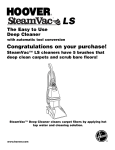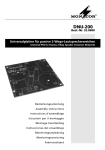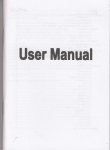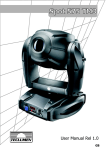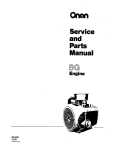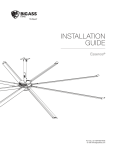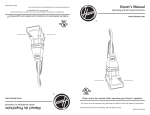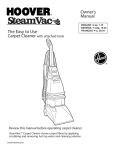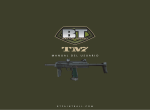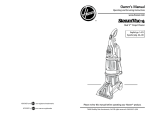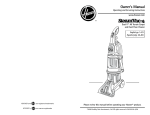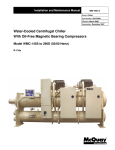Download SteamVac TMWith Attached Tools And Automatic Tool Conversion
Transcript
SteamVac TMWith Attached Tools And Automatic Tool Conversion SteamVacs with the automatic feature were first introduced Characteristics Supreme: Deluxe: Ultra: tool conversion in mid-1997. Fig. 1 of the three types: No rotating brushes Five rotating brushes (for carpet only). Five rotating brushes for carpet and a powered hand nozzle for upholstery. DELUXE ULTRA SUPREME These are the third generation of Steam Vats made by Hoover for the domestic market. All models have: • 1 gallon tanks, solution and recovery • 8 foot hoses • Quick cord release (back of handle) • Tool/floor mode indicator Fig. 2 • Automatic tool conversion • 16 oz. pre-cleaner-spray bottle • 16 oz. carpet/upholstery detergent • Bare floor cleaning 5 OUNCES/ 15Oral Easy, One-handed tankremoval • Upholstery tool, fits front of nozzle. Fig. 3 nozzle • 1 Speed motor • Measuring eup/eap on solution tank.Fig. 4 • Over flow float in recovery tank liJ 10/97 • Foot operated on and off switch • One handed recovery tank removal. Fig. 5 Deluxe brushes. and Ultra Fig. 6 Tile brushes Fig. 7 TURBINE models are driven have 5 mlcllocking by an air pOWeled rotating turbine _- BRUSIt Rotation of tile brush can be viewed though a cleai cover on the hood. The Speed of the brush depends on air flow and is adjustable for Lo or Hi rotation or can be turned off completely as might be desired when cleaning bare floors. Fig. 8 BLOCK There are 3 major systems in Steam Vacs: 1. Electrical 2. Distribution 3. Recovery The Electrical System - Fig. 9 consists of the power supply cord, motor and on/off switch. Close the switch, the motor runs and provides suction for recovery at the floor or the upholstery tool. It also generates air flow to drive the turbine to rotate the brushes at the floor and in the powere d wand plus drive the pump to force solution to the upholstery tool. J._ E:t ELECTRICAL SYSTEM The Distribution System - Fig. 10 When the solution tank is placed on the unit, a valve in the tank opens and fills the reservoir and the tube leading to the pump. With the unit turned on and the handle in the upright position, the pump runs and sends water to the wand for above the floor cleaning Fig. 10A DISTRIBUTION SYSTEM PLUNGER /SLIDE VALVE CAP SOLUTION ,TANK SUN TEA VALVE POPPET MOTOR RESERVOIR • PUMP _TURBINE __ I0197 MOTOR When the handle is lowered to tile operating positiot, the pump shuts off and the floor brushes (5) start to rotate (unless turned off manually) Fig. 10B When the trigger on the handle is depressed, a solution valve in tile reservoir is opened and water flows. to the rotating brushes. Tile Recovery System. Recovery from tile floor is shown in Fig. 11 With the handle in the operating position, the pump is off and the valve to the tools closed. All suction is at the floor nozzle. € Recovery at the upholstery tool is shown in Fig. 12. With the handle in the storage position the pump runs, and the valve to the floor is closed diverting all suction to the upholstery tool. Key components of the SteamVac Ultra are shown ir the cut away views on the next page. ) ROTATING BRUSHES Refer to the Hoover Service Manual for repair proce dures and the Microfiche Parts Catalog, purple header for spare parts. HOSE RECOVERY TANK LID TANK MOTOR MOTOR PUMP FRONT VALVE DIRTY AIR WATER 10/97 CLEAN AIR FLOOR DIRTY AIR WATER CLEAN AIR FLOOR HOSE SOIM_ON TANK MEASURING CI_/CAP SOLI.rrION TRIGGER CLEAN TANK RECOVERY TANK HANDLE HANDLE TANK SOLUTION CONTROL ROD BARE H.f)OR TOOL RESERVOIR PUMP BRUSH BLOCK CORD HOOK ON/OFF 10/97 PEDAL FROM PUMP FROM _-_ 10/9"/ PUMP SERVICE INSTRUCTIONS CARPET CLEANING MACHINE STEAMVAC Service Support 10/97 Latch R H I I Seal Duct Svatch Button Hose Motor Cover / Valve Assembly Seal I Motor w • Seal • Actuator Arm Switch Pedal Attachment Cord Whee_ Brush Bloct( Assembly Upper Hand_P°wered Control Rod Tool_ Lower SWitCh Rod Tool Holder // S_alo Relief Lower Handle Solution Tube Cover Float , Trigger Recovery Tank Lid Recovery Tank Foam F_ter I. General then drawn recovery The SteamVac Conversion for deep TM with Automated is a self contained cleaning of carpet Tool extractor up through tank where separated, designed recovery the valve and into the the air and water are A float and foam filter prevent tank from being the overfilled. and rugs The pump These models feature the Automated Tool motor. Conversion actuated by the handle movement. Mid line models include 5 rotating brushes for carpet and bare floor agitation. While top end models also include an air driven hand nozzle. This instruction deals with top of the line models. Instructions that pertain to low end models will be noted. operates Suction on the suction is directed from the to the pump through the pump duct (an integral part of the mainbody), and is completed at the valve which is actuated by raising the handle into the upright position. The pump has a constant flow of solution from the solution tank through the reservoir assembly. The five rotating brushes are driven by a turbine, which operates on the suction from the motor. II. Operation The recovery tank can be unlatched by rotating the handle 90 ° and lifting out of position. To empty tank continue rotating handle an additional 90 ° and lift lid from tank. The units are controlled by the on/off pedal located on the LH. side. The Automatic Tool Conversion uses a valve which diverts the suction from the nozzle to the hose when the handle is placed in the upright position. ON/OFF PEDAL III. Disassembly A. Solution Solution is gravity fed to the floor from the solution tank through the reservoir assembly the distributor/brushes. to Tank To remove, unlatch and pull tank assembly out of position as illustrated (Fig. 1). ROTATING BRUSHES HANDLE CLEAN SOLUTION Fig. 1 The reservoir is opened in the handle. by actuating the trigger Suction is directed to the floor through the smoke colored nozzle and air duct. The suction air is Replaceable cap gasket components and poppet of the tank valve. assembly, B. Cap Assembly 1. Twist off to remove (Fig. 2) SPRING.-._ WASHER7_ VALVE SE*L--C Fig. 3A VALVE STEM -_ The cupped end of the valve seal faces downward upon reassembly. To reassemble valve: Fig. 2 2. Slide gasket offto replace faces toward cap). (Rib on gasket 1. Slide valve assembly into valve seat through opening in bottom of tank (Fig. 4). Use a small amount of soap on seal to ease assembly. /" C. Poppet Valve 1. Insert screwdriver through tank opening and push valve until it snaps out of seat. (Fig. 3) 2. With small screwdriver, work rubber washer into housing (Fig. 5). Fig. 3 2. Work valve stem out of tank from underneath. 3. The spring, brass washer and valve seal will stay trapped in the valve seat. Remove through tank opening. Note position in Fig 3A. 3. Continue to slide shaft in until it stops. 4. Valve should spring open and closed when fully seated. D. Upper Handle Assembly For models other than those with the Powered Hand Tool, steps 1 and 2 are omitted. 1. Remove two bolts and slide handle off (Fig. 6) E. Recovery Tank 1. Release handle to lowest position, (R.H. Pedal). 2. Rotate tank handle 90° upward and lift out of position (Fig. 8). Fig. 6 The upper handle is replaced as an assembly. To replace upper handle rod: Ultra Models J 1. Remove Powered Hand Tool, (Note: Powered Hand Tool door can be removed by opening until door snaps off of hinges). 2. Remove tool holder Fig. 7 by snapping out of position. Fig. 8 3. To remove lid assem, rotate handle an additional 90 ° and lift lid from tank. The lid is carried in service as an assembly that includes the lid, float retainer, float, and tank filter. F. Recovery Tank Duct 1. Remove (3) screws (Fig. 9) and lift out of )osition. J i Fig. 7 3, Upper handle rod may then be removed twisting "jiggling" out of position. by Note: To reposition rod slide up and into handle with fin labeled "Front" facing the front of the cleaner. Rod will latch into position. Fig. 9 G. Hood H. Hose 1. Remove agitator speed actuator button. 2. Remove (2) screws (Fig. 10). Screw 1. Hose Connection a. Flex tab (Fig. 12) to free hose connection valve. to _crew Fig. 10 3. Carefully pry inward on rear panels of hood to release (Fig. 11). Fig. 12 2. Hose Strain Relief a. Release tab by pushing up and in on lower tab and then release upper tab to slip hose clear from handle (Fig. 13). Fig. 11 Note: On Ultra Models or models with outer flaps on hood, flex hood to clear tab on inside of main body. Hint: Start on same side as standpipe. 4. Pivot hood forward out of position. Fig. 13 I. Hose Service The hose is replaced grip end: as an assembly. To service 1. Remove the two screws in the hand grip and remove cover. 2. Depress the nozzle/valve assembly and unlatch the trigger. The nozzle/valve assembly spring loaded. ( Fig. 14) 2. Slide control arm off of valve and release from lever and spring. 3. Remove turbine control arm and spring assem by depressing tab on turbine (Fig. 16). is Fig. 16 4. Lift lever slightly and slide forward until lever is free from unit. 5. Slide actuator arm forward off of pump. K. Turbine (Deluxe and Ultra Models Only) Fig. 14 J. Valve Lever 1. Remove screw while holding spring in position. Note position of spring before removing (Fig. 15) The turbine will be replaced as a turbine assembly complete. 1. Remove (2) screws from bottom (Fig. 17). I Screw ,_* Screw Fig. 15 Fig. 17 2. Remove (2) screws located at front of turbine. 3. To lift out of position flex outer walls of main body to clear tabs. 3. Disconnect hose from turbine and lift out of position. 4. Feed tubes through K. Pump M. Motor 1. Remove doghouse. (1) screw located on pump 2. Release tab with flat blade screwdriver bottom of unit (Fig. 18). motor cover and remove. 1. Remove hood. 2. Remove recovery tank duct. 3. Remove hose connection from at valve. 4. Remove valve lever. 5. Remove turbine assembly. 6. Remove motor cover/valve 7. Disconnect assembly. all lead wires. 8. Lift motor out of position. Note: Fig. 18 3. Disconnect Motor is replaced N. Attachment hoses from pump. as an assembly only. Cord 1. Disconnect all lead wires. L. Motor CoverNalve Assembly 1. Remove standpipe seal. 2. Remove strain relief from underneath unit by squeezing tabs and pushing through housing. 2. Remove (6) screws (Fig. 19) Note: Upon reassembly, route cord as shown in Fig. 20. Also, it is very important to reconnect the ground lead. Fig. 19 Fig. 20 O. Brush Block Assembly Models) (Deluxe/Ultra 2. Disconnect _osition. leads and snap switch out of To remove brush block assembly simply squeeze block at tabs shown in Fig. 18 and slip brush block assembly out of position. To reinstall brush block assembly align slides on sides of block with slots in main body and snap brush block assembly back into position. 3. The switch pedal can be removed trunnion is lifted. P. Handle 2. Release two tabs and lift cover off. (Fig. 23) The Release RH trunnion Lever traps the handle release Slide lever inward then up to remove. R. Handle once the Cover 1. Remove upper handle. lever. (Fig. 21) Fig. 23 S. Lower Rod Fig. 21 Q. SwitchlSwitch 1. Trapped in place by handle cover. Lift out to remove. (Fig. 24) Pedal 1. The L.H. trunnion houses the on/off switch and traps the switch lever. (Fig. 22) TRUNNION SWITCH SWITCH :7. Fig. 22 Fig. 24 T. Reservoir 1. Release lower U. Motor Seal Assembly two clips handle and remove from cradle in (Fig. 25) The motor seal is positioned shown. (Fig. 27) below the motor as Fig. 27 Fig. 25 V. Standpipe The reservoir is replaced does not include tubing. as an assembly Seal which 1. Press fit to standpipe (Fig. 28). The reservoir assembly can be inspected by removing the diaphragm valve and checking the chamber valve (Fig. 26). toremove __ / Fig. 28 W. Rear Wheel 1. Remove "E" clip and slide wheel shaft out of housing. (Fig. 29) t F Fig. 26 Note: Tubing tubing is 3/8" ID. Note tubing is available All other routing in service. Pump is 1/4" ID. through motor cover for reassembly. Fig. 29 MAIN _)OY IV. Troubleshooting check list - Steam Vac TM w/Automated tool conversion The following is a guide to aid in determining the origin of a problem for which these models could conceivably be brought in for service. Problem Possible A. Motor won't run 1 2. 3 4 5. 6. 7. 8. B. Unit won't distribute water to floor C, Unit won't extract water at floor nozzle Cause Unit not firmly plugged in No voltage at wall outlet. Open in attachment cord Switch failed Switch lever failed or out of position Crimp connection. Open circuit in motor. Motor brushes stuck or worn. Possible Check cord for proper connections. Plug into a known good source Check and replace cord. Replace switch. Replace or reposition lever. Check connections. Replace motor. Work brushes in holder to assure free movement. If brushes are worn or "pitted" from arcing., replace motor. Replace or tighten trunnion. 9. R.H. trunnion cracked/loose. 9. 1 2. Solution tank empty. Poppet valve malfunctioning. 1. 2. 3. 4 Solution tank opening clogged. Valve in reservoir assembly failed. 3. 4. 5. 5. 6. 7. 8. Tubing to distributor kinked/pinched from improper assembly. Distributor clogged. Trigger in handle malfunctioning. Upper control rod malfunctioning. 9. Lower control rod damaged or missing 9. 6. 7. 8. 1. Obstruction in nozzle, duct or valve 1. 2. 3. 4. 5. 6. 2. 3. 4. 5. 6. 7. 8. Recovery tank full Standpipe seal missing or damaged. Recovery tank lid seal damaged. Duct seal missing or damaged. Seal at junction of valve to recovery tank missing or damaged Motor seals missing or damaged. Handle locked in upright position. 9. Motor fan damaged. 10. Motor failed or mounting loose. 11. Valve malfunctioning. 12. Pin on lower handle missing. Solution 1 2 3 4. 5. 6. 7. 8 7. 8. Refill and check operation. Check and replace - located in bottom of solution tank. Clean and check operation. Check for obstruction - if clear replace reservoir. Trace tubing and check for kinks. Clean or replace if necessary. Check and replace if necessary. Check to insure rod is connected to trigger and is not broken. Check and replace or reposition. Remove recovery tank and sight into valve. Also check duct from valve to nozzle. Empty tank and recheck operation. Replace seal. Replace lid assembly. Replace seat. Replace seal. Replace seals. Handle must be in operators position to divert suction to the floor. 9. Replace motor. 10. Check, replace motor if necessary. 11. Check. With handle in operators position, valve should be positioned to shut off suction to the hose. Replace motor cover / valve assembly if necessary. 12. Pin is positioned to catch on actuator arm and snap valve into position when handle is lowered. Check for pin located in lower handle directly above R.H. trunnion. Replace if missing. IV. Troubleshooting The following conceivably check is a guide be brought list - Steam Vac to aid in determining TM wlAutomated the origin tool conversion of a problem Cause Possible Possible D. Unit won't pump. (no spray from hose) 1 2 Solution tank empty Poppet valve malfunctioning. 1 2 3 4 5 6. 3 4. 5 6 7. 8. Solution tank opening clogged Handle not locked into upright position Reservoir assembly clogged Tubing to pump or from pump to solution hose coupler kinked. Pump air intake duct clogged. Pump failed. 9. Actuator Arm malfunctioning. 9. 10. Solution hose to wand clogged. 11. Solution hose to wand damaged. 12. Valve in hose grip failed. F. Brushes on Hand tool wile not run 1. Turbine switch in off position. 2. Brush block jammed. 3. Drive pin on center brush broken. 4. Spring on turbine arm broken or missing, 5. Actuator arm on turbine broken. 6. Air flow to or from turbine clogged. 7. Cleaning indicator not showing "floor cleaning" 7. 8 models could Solution Refill and check operation Check and replace - located in bottom of solution tank. Clean and check operation Raise handle and check operation Check and clean or replace Trace tubing and check for kinks Clean and check operation. Check to insure pump is securely mounted and that suction air is present at mounting point. Replace pump if failed, The actuator arm connects to the valve crank arm and is forced forward when the handle is raised to the upright position. This exposes the pump inlet. 10. Solution hose is routed inside of the suction hose. Attempt to flush hose if clogged, 11. Replace hose assembly. 12. Replace wand / valve assembly 1. 2. 3. 4. Turn on turbine. Remove object causing jam. Replace brush block assembly. Replace spring. 5. 6. 7. Replace turbine. Remove clog. Check screen in hood assembly Check to insure handle is in operators position. Turbine will not run with handle locked upright. Replace turbine - check items 1-9 prior to replacing turbine, 8. Turbine failed. 1. Handle not in upright position. 1. 2. 3. 4. 5. Air vents clogged on hand tool. Brushes jammed. Turbine in hand tool failed. Cleaning indicator not showing" tool cleaning". Hose connection loose. 2. 3. 4. 5. 6. these in for service. Problem E. Brushes will not run, for which 8, 6. Lift handle until it locks into upright position. Clean vents. Remove object causing jam. Replace hand tool. Check valve and lever for proper assembly. Check hose connection at valve. Also check strain relief for proper assembly. Troubleshooting SteamVac w/Automated Guide Tool Conversion The following is a guide to aid in determining the origin of a problem for which these models could conceivably be brought in for service.. Problem Possible Cause Possible Solution A. Motor won't 1 2. 3. 4. 5. 6. 7. 8. Unit not firmly plugged in. No voltage at wall outlet. Open in attachment cord. Switch failed. Switch lever failed or out of position. Crimp connection. Open circuit in motor. Motor brushes stuck or worn. 1. 2. 3 4. 5. 6 7. 8. 9. L.H. trunnion cracked/loose. 9. 1. 2. Solution tank empty. Poppet valve malfunctioning. 1. 2. 3. 4. Solution tank opening clogged. Valve in reservoir assembly failed. 3, 4. run B. Unit won't distribute water to floor Tubing to distributor kinked/pinched from improper assembly. 6. Distributor clogged. 7. Trigger in handle malfunctioning. 8. Upper control rod malfunctioning. 5. 9. Lower control rod damaged or missing 9. 1. Obstruction in nozzle, duct or valve 1. 2. 3. 4. 5_ 6. Recovery tank full. Standpipe seal missing or damaged. Recovery tank lid seal damaged. Duct seal missing or damaged. Seal at junction of valve to recovery tank missing or damaged Motor seals missing or damaged. Handle locked in upright position. 5. C. Unit won't extract water at floor nozzle 7. 8. 9. Motor fan damaged. 10. Motor failed or mounting loose. 11. Valve malfunctioning. 12. Pin or_lower handle missing. 6. 7. 8. Check cord for proper connections Plug into a known good source Check and replace cord. Replace switch. Replace or reposition lever. Check connections Replace motor. Work brushes in holder to assure free movement. If brushes are worn or "pitted" from arcing., replace motor. Replace or tighten trunnion. Refill and check operation. Check and replace - located in bottom of solution tank. Clean and check operation. Check for obstruction- if clear replace reservoir. Trace tubing and check for kinks. Clean or replace if necessary. Check and replace if necessary. Check to insure rod is connected to trigger and is not broken. Check and replace or reposition. Remove recovery tank and sight into valve. Also check duct from valve to nozzle. 2. Empty tank and recheck operation. 3. Replace seal. 4. Replace lid assembly. 5. Replace seal. 6. Replace seal. 7. 8. Replace seats. Handle must be in operators position to divert suction to the floor. 9. Replace motor. 10. Check, replace motor if necessary. 11. Check. With handle in operators position, valve should be positionedto shut off suction to the hose. Replace motor cover / valve assembly if necessary. 12, Pin is positioned to catch on actuator arm and snap valve into position when handle is lowered. Check for pin located in lower handle directly above R.H. trunnion. Replace if missing. D.Unitwon't pump. (nospray fromhose) 1. Solutiontankempty 2 Poppetvalvemalfunctioning. 1 2 Refill and check operation Check and replace - located of solution tank 3 4 5 6. Solutiontankopeningclogged Handlenotlockedintouprightposition Reservoir assembly clogged. Tubingtopumpor frompumptosolution hosecouplerkinked 7. Pumpairintakeductclogged. 8. Pumpfailed 3 4 5 6 Clean and check Raise handle and Check and clean Trace tubing and 7 8 9. ActuatorArmmalfunctioning. 9. Clean and check operation. Check to insure pump is securely mounted and that suction air is present at mounting point. Replace pump if failed. The actuator arm connects to the valve crank arm and is forced forward when the handle is raised to the upright position. This exposes the 10.Solutionhosetowandclogged. 11.Solutionhosetowanddamaged. 12.Valvein hosegripfailed. E. Brushes will not run. F. Brushes on Hand tool will not run 1. Turbine switch in off position. 2. Brush block jammed. 3. Drive pin on center brush broken. 4. Spring on turbine arm broken or missing. 5. Actuator arm on turbine broken. 6. Air flow to or from turbine clogged. 7. Cleaning indicator not showing "floor cleaning" operation check operation or replace check for kinks - pump inlet. 10. Solution hose is routed inside ofthe suction hose. Attempt to flush hose if clogged. 11. Replace hose assembly. 12. Replace wand / valve assembly 1. 2. 3. 4. Turn on turbine. Remove object causing jam. Replace brush block assembly, Replace spring. 5. 6. 7 Replace turbine. Remove clog. Check screen in hood assembly Check to insure handle is in operators position. Turbine will not run with handle locked upright. Replace turbine - check items 1-9 prior to replacing turbine. 8. Turbine failed. 8. 1, Handle not in upright position. 1. 2. 3, 4. 5. Air vents clogged on hand tool. Brushes jammed. Turbine in hand tool failed. Cleaning indicator not showing "tool cleaning". Hose connection loose. 2 3. 4. 5. 6. in bottom 6. Lift handle until it locks into upright position. Clean vents. Remove object causing jam. Replace hand tool. Check valve and lever for proper assembly. Check hose connection at valve. Also check strain relief for proper assembly.























